2018 | OriginalPaper | Buchkapitel
6. Blackness and Banal Whiteness: Abjection and Identity in the Italian Christmas Comedy
verfasst von : Alan O’Leary
Erschienen in: Comedy and the Politics of Representation
Aktivieren Sie unsere intelligente Suche, um passende Fachinhalte oder Patente zu finden.
Wählen Sie Textabschnitte aus um mit Künstlicher Intelligenz passenden Patente zu finden. powered by
Markieren Sie Textabschnitte, um KI-gestützt weitere passende Inhalte zu finden. powered by
